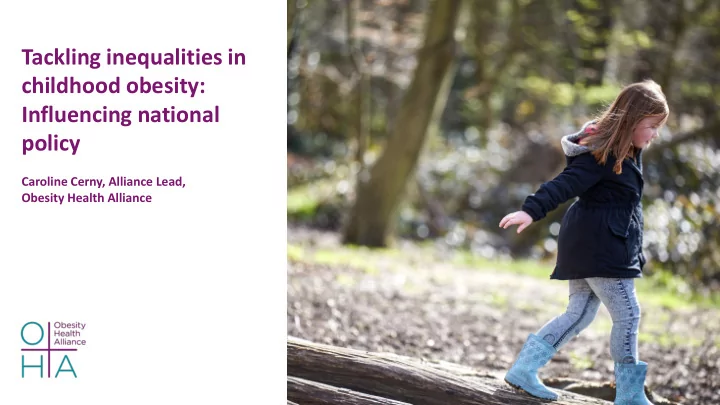

Tackling inequalities in childhood obesity: Influencing national policy Caroline Cerny, Alliance Lead, Obesity Health Alliance
About Obesity Health Alliance • 45 organisations • Speak with one voice on obesity policy
Obesity prevalence by deprivation decile National Child Measurement Programme 2017/18 30% Year 6 Reception 26.8% 25% 25.7% 23.8% 21.9% 20% 20.0% Obesity prevalence 18.5% 16.9% 15% 15.7% 14.0% 12.8% 12.0% 11.7% 10% 11.0% 10.1% 9.4% 8.5% 7.8% 7.5% 6.8% 5% 5.7% 0% Most Least deprived deprived Index of Multiple Deprivation 2015 decile Child obesity: BMI ≥ 95 th centile of the UK90 growth reference 3 Patterns and trends in child obesity
Severe obesity prevalence by deprivation decile National Child Measurement Programme 2017/18 8% Year 6 7% Reception 7.0% 6% 6.2% Severe obesity prevalence 5.5% 5% 4.7% 4% 3.8% 3.9% 3.5% 3.5% 3% 3.0% 2.8% 2.7% 2.6% 2% 2.2% 2.0% 1.9% 1.6% 1.6% 1.5% 1% 1.3% 1.0% 0% Most Least deprived deprived Index of Multiple Deprivation 2015 decile Child severe obesity: BMI ≥ 99.6 th centile of the UK90 growth reference 4 Patterns and trends in child obesity
Role of national policy • Population level interventions – likely to have most positive effect on health inequalities • Universal interventions to restrict or modify choice – most effective behaviour change Individual Likely increase Agentic decision making inequalities Agento- Environment + Impact uncertain structural behaviour Change Can reduce Structural environment inequalities
Policy priorities PROBLEM POLICY POLITICS Needed Workable Wanted
Policy priorities PROBLEM POLICY POLITICS Needed Workable Wanted Children’s excess sugar Significant variation 83% of public support and calorie intake across categories voluntary reformulation (73% regulation) Some manufacturers leading the way on sugar reduction Structural : Lower income groups have highest level of sugar in their diets - potential to disproportionately impact inequalities
Policy priorities PROBLEM POLICY POLITICS Needed Workable Wanted Voluntary action by some 66% of public support Price promotions such as supermarkets show supermarkets being ‘buy one get one free’ change is possible. made to promote and multi-buy offers healthier foods more common on unhealthy food products. Structural : Promotions generally cause people with less money to spend more, due to triggering impulse purchasing
Policy priorities PROBLEM POLICY POLITICS Needed Workable Wanted The more junk food ads Limited restrictions 72% of public support on TV young people see, already apply 9pm watershed / 70% the more they eat – 500 support restrictions extra snacks per year Evidence based tools in online place 65% of MPs Structural : Teens from more deprived backgrounds 40% more likely to recall seeing ads – potential to disproportionately impact inequalities
Looking ahead… a new narrative? "If we want kids to lose “Taxes on treats hits weight we should those on lowest incomes. encourage kids to walk We should be and cycle to school and #freetochoose .” generally do more exercise. It’s calories in, and calories out. Child obesity is a problem heavily skewed to particular groups, demanding community-level solutions targeted at where the problem is to maximise effectiveness.
Thank you caroline.cerny@obesityhealthalliance.org.uk @OHA_updates
Recommend
More recommend